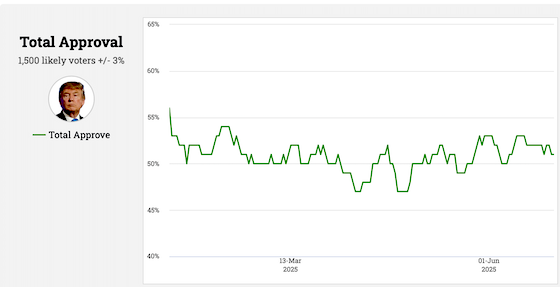The last week has seen one of President Trump’s most brilliant successes, the bombing of Iran’s nuclear enrichment facilities. That military strike, carried out with nearly unparalleled secrecy and precision, may have spared one or more American cities from being destroyed by a nuclear warhead–something that, presumably, even Democrats do not want to see.
And yet Trump’s approval rating has not budged. The best source for such trends is Rasmussen, not because its numbers are more “right” than other pollsters’, but because it polls continuously, using the same methodology and reporting three-day rolling averages. So it is an excellent barometer of trends.
Only these days, there are no trends. This is Trump’s approval rating from the beginning of his term to the present:
The incredibly successful Iranian mission has had literally zero impact. For that matter, nothing that has happened during the last five months has made much difference, either positively or negatively. The approval and disapproval of President Trump are locked in at virtually the same levels that we saw in November’s election.
We are in an era of what one could call political trench warfare–enormous effort expended, but virtually no movement in the adversaries’ lines. The two sides in American political life, the left and the right, are so dug in and so committed to their respective teams that nothing sways them. If you are on the left, Trump’s Iranian success doesn’t cause you to shift allegiance to Trump, any more than the opposing team scoring a touchdown causes you to abandon your own team and root for them.
I could be wrong–it would be an interesting research project–but I am pretty sure that in earlier political eras (i.e., until the last 20 years or so) there was more movement in presidential approval ratings. People changed their minds based on events, an eminently rational thing to do. But that doesn’t seem to be happening anymore.
No doubt this is partly due, at least, to the current bifurcation of sources of information. People who are unimpressed by Trump’s magnificent success in Iran, i.e., pretty much everyone who wasn’t already on Trump’s team, get their news from sources like the New York Times, CNN, and The View. These outlets are so absurdly biased that no well-informed person takes them seriously, but liberals don’t know that. They probably think, based on the “news” they see, that Iran never posed a threat to the U.S.; that the mullahs were just kidding about “death to America;” that Barack Obama’s masterful diplomacy prevented the Iranians from getting the bomb; that prior to our attack they were nowhere near an effective nuclear weapon; and that the attack itself did little damage, but only made America look like the aggressor in the eyes of the world.
Therefore, Trump’s successful attack didn’t cause them to rethink their evaluation of him. On the contrary, it confirmed their already-existing prejudices.
So here we are: America in 2025 is the Somme in 1916. Progress on either side is so slow and so costly as to be non-existent.
What can break the current deadlock? Only broad demographic changes. Minorities and young people are trending Republican. If that continues, 51% will turn to 53% or 54%, enough to provide winning margins for years to come. That is the hope, at least. But for now, the lines are clearly drawn, and events aren’t changing them.
















